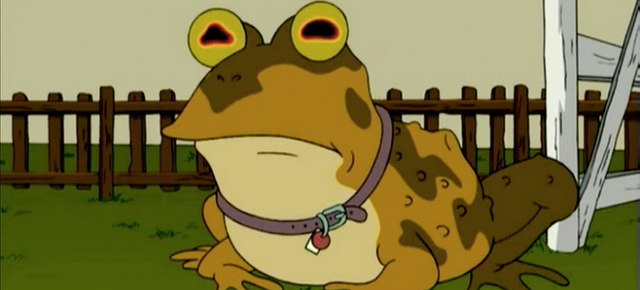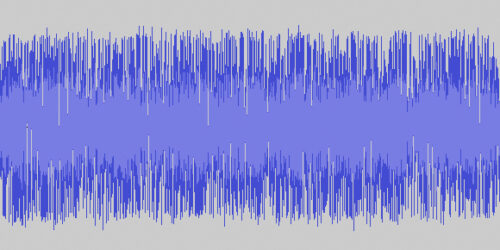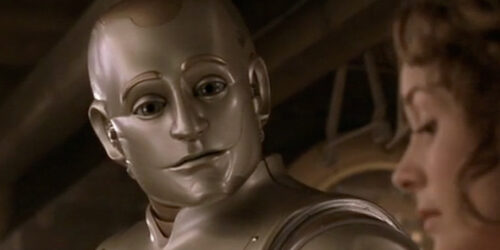Captioned hypnosis

Recurring sounds on TV shows allow us to explore questions of consistency and accuracy in closed captioning. Consider the Hypnotoad as a compelling case study.
What the Hypnotoad can teach us about closed captioning
Recurring sounds on TV shows present us with an opportunity to explore questions of consistency and accuracy in closed captioning. When a sound recurs in the same context or originates repeatedly from the same character, should it be captioned consistently? Moreover, given a number of different, presumably viable options for captioning the same recurring sound/character, which option is best?
These aren’t easy questions, especially since captioning done well must be done in specific visual contexts. Still, it’s hard not to ask such questions when confronted with recurring sounds in recurring contexts. I’ve previously explored the various ways in which a running gag is captioned on Family Guy. Here, I want to track how the same sound — the Hypnotoad’s hypnotic drone — is captioned across multiple episodes of Futurama. Though a minor character on the show, the Hypnotoad is reportedly “one of Matt Groening’s favorite characters.”
What’s particularly interesting about the Hypnotoad’s drone is that the visual context for the hypno-sound is nearly identical through every occurrence. The Hypnotoad seems to be limited to making only one sound and taking one action. In other words, the context remains fairly constant across every occurrence of the hypno-sound. The hypnotoad is nearly always shown making the same sound and taking the same basic action. With context held fairly constant, then, we can focus on the different ways in which the hypno-sound is captioned, attributing differences in captions to the preferences of captioners as opposed to fluctuations in context.
The Hypnotoad sound also reveals the important role that visual context plays in captioning. Simply knowing that the hypno-sound is in fact a “turbine engine played backwards” is insufficient. Captioners don’t caption sounds in isolation. The actual origin of a sound may be unimportant. While it would be technically correct to caption the Hypnotoad sound as a “turbine engine played in reverse,” it wouldn’t be contextually correct. Captions do not simply convey the origin of a sound — or even what the sound really is in any abstract, technical, or decontextualized sense — but what the sound is doing in a scene.
As you view the clips, consider the differences among the official hypno captions. Do you have a preference? Why? How important is consistency when captioning a recurring sound such as the hypno-sound?
“The Day the Earth Stood Stupid”
- Season 3, Episode 7 (2001)
- Plot info: “The Day the Earth Stood Stupid“
- Source: Netflix
- Hypnotoad appears at: 01:52 (video 1), 04:55 (video 2) (DVD captions are the same. I do not have the TV captions produced by WGBH.)
“Bender Should Not Be Allowed on Television”
- Season 4, Episode 6 (2004)
- Plot info: “Bender Should Not Be Allowed on Television“
- Source: Netflix (video 1) and Broadcast TV (video 2). (DVD captions are the same.)
- Hypnotoad appears at: 03:57
“Bender’s Big Score”
- 89-minute film (2007)
- Plot info: “Bender’s Big Score“
- Source: DVD (video 1) and Netflix (video 2). Same scene, different captions.
- Hypnotoad appears at: 01:05:37
“Everybody Loves Hypnotoad: Amazon Adventure”
- 22-minute “extra” on the DVD for Bender’s Big Score (2007)
- Plot info: “Everybody Loves Hypnotoad“
- Source: DVD
- Hynptoad appears throughout the 22-minute “episode” (only the first minute is included below)
- Uncaptioned (typical for DVD extras)
“Into the Wild Green Yonder”
- 84-minute film (2009)
- Plot info: “Into the Wild Green Yonder“
- Source: DVD (Netflix captions are the same.)
- Hypnotoad appears at: 27:15
- Uncaptioned (Hypnotoad and hypno-sound appear briefly in background)
“Rebirth”
- Season 6, Episode 1 (2010)
- Plot info: “Rebirth“
- Source: DVD (Netflix captions are the same. I do not have the TV captions produced by WGBH.)
- Hypnotoad appears at: 0:00 (episode opens with Hypnotoad)
“Attack of the Killer App”
- Season 6, Episode 3 (2010)
- Plot info: “Attack of the Killer App“
- Source: DVD (video 1) and Broadcast TV (video 2). Same scene, different captions. Netflix and DVD are the same.
- Hypnotoad appears at: 07:03
“Lrrreconcilable Ndndifferences”
- Season 6, Episode 11 (2010)
- Plot info: “Lrrreconcilable Ndndifferences“
- Source: DVD (video 1) and Broadcast TV (video 2). Same scene, different captions. Netflix and DVD are the same.
- Hypnotoad appears at: 09:32
Summary
| Futurama Episode or Movie | Hypnotoad Caption |
|---|---|
| The Day the Earth Stood Stupid (2001) | (Electronic Humming Sound) [Netflix and DVD] (Electronic Humming) [Netflix and DVD] |
| Bender Should Not Be Allowed on Television (2004) | (Eyeballs Thrumming Loudly) [Netflix and DVD] (sustained electrical buzzing) [Broadcast TV] |
| Bender’s Big Score (2007 movie) | (droning mechanical sputtering) [Netflix] (Mechanical Grinding) [DVD] |
| Everybody Loves Hypnotoad (DVD special feature on Bender’s Big Score) | Uncaptioned [DVD] |
| Into the Wild Green Yonder (2009 movie) | Uncaptioned [Netflix and DVD] |
| Rebirth (2010) | (LOUD BUZZING DRONE) [Netflix and DVD] |
| Attack of the Killer App (2010) | Uncaptioned [Netflix and DVD] (mechanical humming) [Broadcast TV] |
| Lrrreconcilable Ndndifferences (2010) | Uncaptioned [Netflix and DVD] (electronic static) [Broadcast TV] |
Analysis
When we reach across episodes and put captions for the same sound side-by-side, we also put ourselves in an excellent position to make an informed decision about which caption, if any, we think is best. Even if we ultimately decide that any of these options will suffice, we can at least be struck by their remarkable diversity. This diversity raises a number of questions:
- The Hynpo-sound is converted into a number of mostly synonymous action words: Humming, Thrumming, Grinding, Droning, Sputtering, Buzzing. Will any of these terms suffice, or do we need a term that captures not only the nature of the sound but also its function as hypnotic?
- In one case (“droning mechanical sputtering”), two action words are used in the same caption. Do droning and sputtering together more effectively describe the sound and its function than a single action word?
- Two captions describe the volume of the sound (“Eyeballs Thrumming Loudly” and “Loud Buzzing Drone”). Yet all the instances of the Hypno-sound (except for one) are approximately the same volume. (The exception is “Into the Wild Green Yonder,” in which the Hypno-sound on the TV screen plays quietly in the background.) How necessary is it to indicate sound volume in the Hypno-caption?
- When the Hypno-sound is played quietly in the background of the scene from “Into the Wild Green Yonder,” it is not captioned. The short amount of screen time for the Hypnotoad is dominated by speech from the Professor and the TV announcer. Would it benefit caption viewers to have a description of the Hypno-sound wedged into the scene among the speech captions?
- The origin of the sound is described as electronic, mechanical, or biological (i.e. emanating from the Eyeballs). Does it matter which one it is?
- Only one of the captions indicates the specific location of the sound. “Eyeballs Thrumming Loudly” describes the sound as emanating from the toad’s eyeballs. Locating the source of the sound in the eyeballs is most likely an interpretation on the captioner’s part. The Futurama Wiki states that the Hypnotoad “emits a droning hum” but doesn’t indicate where that sound comes from because, as far as I know, it’s not clear how the toad makes the noise. This caption is particularly interesting to me because it shows how captioners don’t simply caption sounds in isolation but caption sounds embedded in visual contexts. Captioners don’t caption the actual origins of sounds (i.e. the sound is actually “a turbine engine”) but the apparent origins of sounds.
- One caption uses the word “sound.” But viewers already assume that captions describe sounds, so adding the word “sound” to any caption is usually a waste of precious caption space.
- One caption is in ALL CAPS.
- DVD, Netflix, and Broadcast TV captions for the same episode will not necessarily be the same.
- DVD extras are not usually captioned in my experience. In order to make DVDs fully accessible to deaf and hard of hearing caption viewers, extras and special features on DVDs must be captioned, starting with the 22-minute episode of “Everybody Loves Hypnotoad.”
[A note on method: The closed captions included with the clips are the official captions. I used the Futurama Wiki to gather a list of episodes in which the Hypnotoad character appeared. According to the Futurama Wiki, the Hypnotoad appears in three episodes, two feature-length movies, and one 22-minute DVD extra. I recently identified two additional appearances of the Hypnotoad in “Attack of the Killer App” (2010) and “Lrrreconcilable Ndndifferences” (2010). I viewed every appearance on DVD, Netflix streaming, and Broadcast TV, with the exception of “Rebirth” and “The Day the Earth Stood Stupid.” I am still waiting for these two episodes to appear on TV so I can record them. WGBH has captioned Futurama episodes for TV since season 1.]
[Fair use notice: The videos on this site are transformative works used in good faith, in keeping with Section 107 of U.S. copyright law, and as such constitute fair use of copyrighted material. Read this site’s full fair use notice.]






On your list of choices:
“Electronic humming” doesn’t work because “humming”, by definition, is a soft sound, and Hypnotoad’s sound isn’t soft.
“Droning mechanical sputtering” doesn’t work because “sputtering” contradicts “droning” (i.e., “droning” is a continuous sound; if a sound is sputtering, it’s not continuous and therefore isn’t droning).
“Loud buzzing drone” could work, although “buzz” doesn’t adequately describe, for me, what I hear in Hypnotoad’s sound.
“Mechanical grinding” is okay, although, again, I wouldn’t use “grinding” to describe what I’m hearing. I hear more of a roar.
“Eyeballs thrumming loudly” is my choice for a couple reasons. “Thrum” is an uncommon word with a slippery definition. (My OAD calls it a rhythmic humming sound, but then uses the sound of huge engines as an example; “huge” engines would probably do more than merely hum. The AHD calls it a “monotonous drone”; Hypnotoad’s sound is certainly monotonous but louder than a drone. M-W declines to define the word; the OED relates it more to weaving and botany than sound production.) Since Hypnotoad’s sound and behavior are bizarre, I think a chameleon word like “thrum” is best suited.
Should the caption say that the eyeballs specifically are doing the thrumming? Since it really isn’t clear that the eyeballs are producing the thrum (only that the sound and the flashing occur simultaneously), it may not be strictly accurate. In fact, in “Everyone Loves Hypnotoad”, his eyeballs flash throughout, but there’s no thrumming (or droning or humming or grinding or sputtering) until the final seconds, suggesting that the eyeballs aren’t producing the sound.
In spite of this, I think “eyeballs thrum loudly” is good because it’s a weird caption that fits the weird behavior.
Diane
Diane,
I like how you methodically weighed each option with multiple dictionaries standing by.
Thrumming is an unusual word but since the actual sound is a turbine engine (and your dictionary offers an engine sound as an example of thrumming), it fits nicely. I wonder how accessible the word is?
Sean
You’re forgetting the broadcast versions captioned by WGBH.
That’s a good point, Joe. Netflix and DVD have an on-demand appeal, so I was able to collect episodes relatively quickly. I didn’t have to wait for the episodes to be re-run on TV. But I’ll see if I can find and TIVO broadcast versions. Thanks.
Sean
Sean,
I collect dictionaries.
What do you mean by “how accessible the word is”? Do you mean would people know/recognize it? I’m not sure they would need to know the definition of it because it has an onomatopoeic quality about it.
Diane
Since the sound is specific to Hypno-toad, why not incorporate that information into the caption? Something like “Hypno-toad sound”m or “Hypno-toad droning”?
David
i think most hearing people can vote on this but us deafies cannot. i know most of my former students wouldn not understand humming, thrumming, buzzing etc and it would require creative teaching to bring these ideas into the deaf experience. i have experienced electronic noise but from what i understand about frogs they dont buzz, thrum, hum etc. im lost.
Good point, ReallyRosy. I’m convinced that caption viewers at times need to be highly literate to process some of the descriptive terms used by captioners for non-speech captions. Thrumming is such an unusual word too. I went to my dictionary for that one. I like the way that word sounds but the meaning of the word was not familiar to me.
A usability study involving deaf and HoH readers discussing the different options for the hypnotoad sound would be interesting!
Sean
So maybe we shouldn’t discuss what’s right or wrong about each particular word used to describe a sound, and think of the captioning itself as a performance by the person doing the captioning. Basically, you are watching two shows for the price of one. Not much different then watching an interpreter for a live presentation and picking it all apart because one terp is a CODA and uses local sayings and the other terp never met a deaf person before they decided to take sign language at a prestigious sign language interpreter training program just because daddy was rich enough to send them, and see how the two styles are wildly different. Two artists painting the same lily pond and one looks like Monet and the other looks like Mondrian. Art is similar to beauty – it’s in the eye of the beholder (at the mercy of whatever skill the artist actually possesses, as well as any inspiration that comes along to enhance the end result.). Two photographers can be at the same landscape, and one only has a simple black and white Kodak Brownie Hawkeye and the other has an iPhone loaded with the Histamatic app, but has a palsy in their arms and shakes terribly. The photos from each person will be completely different.
Here, I think each version of how HypnoToad sounds is charmingly unique. It is an interesting exercise to see the different interpretations of how each captionist perceived the sound. Was one captionist a hearing person? was one captionist a late deafened adult listening to the source video with major audio technical headphones (don’t scoff, because 30 years ago, I read in the newsletter produced by the National Captioning Institute a short bio of one of their captionists who WAS very hard of hearing – she used a transcript and listened with great big powerful earphones to hear and then typed the sound out or the words out. There was even a photo of the lady. This was in the days before the WorldWideWeb phase of the Internet).
As for the source of the sound like knowing that it is a recording of a turbine engine being played backwards – hmmm, I’d think that would be distracting in the actual performance. But there is a place for that, if it’s part of a DVD performance, and that would be one of those side shows, where scene outtakes, bloopers, biographical info on the actors, that sort of thing is located. Film producers could conceivably include a discussion from the sound people as to how sounds were made, what technical challenges presented in performing the captions, etc.
Oh another thought is, we don’t know who the viewers are and what their background is – so when you bring the viewers to the table, what you might prefer in terms of caption performance might be different then what I believe I would prefer (I mostly just want whatever English words they use spelled correctly!!) or what someone else watching it might prefer and/or understand, for that matter. Some of these details like how a sound sounds like (droning, buzzing, sputtering) might have no meaning for one person, just because they may be from another country and mentally translating into their language, and maybe their language, people don’t “sputter” or things don’t “dronw”? who know? I’m not a language expert, but I have read about certain concepts important to one language and culture might have many many different words to explain different shades of meaning, and in the English word, there’s only one word. For example – the classic story about the Native Peoples of Alaska or Canada, having something like 30 words in their language that have to do with the concept of “ice” – yet in English, “ice” is “ice”. Maybe “Black ice” for those who might have an understanding of that concept, but parts of the English speaking states in USA and other countries might not ever see snow and ice on the ground in their lifetimes, so “black ice” wouldn’t really even mean anything.
Seems like in my art history classes, we heard that in the Italian and French languages there were far more words used to describe different nuances of art, food, and music than what we use for the same concepts in English speaking countries. Can’t think of any specific examples now, but I do remember Evelyn Glennie’s husband telling me that the Italian word for both “hear” and “feel” is “sentire”. Why do we have one word to describe “hear” that stuff that goes in our ears, and “feel” that stuff we can feel with our hands, when sound itself, depending on the volume, can be both heard and felt? It’s an interesting way to relate to the world, and to think that sometimes the senses are far more integrated then we might imagine.
Anyway, this is just one perspective – I’m hardly so involved as to say that it is the “right” perspective or the “only” perspective, any more than the previously offered comments, all of which add to the overall understanding and perception of the captions as we receive them….
All I can say, is THANK GOD someone out there captions these shows… makes it easier for me to pick through and decide which shows are worth watching and which shows I can just go “move along, nothing to see here..” and quickly change channels. Or turn the HypnoToad show OFF!! (smile!!!)